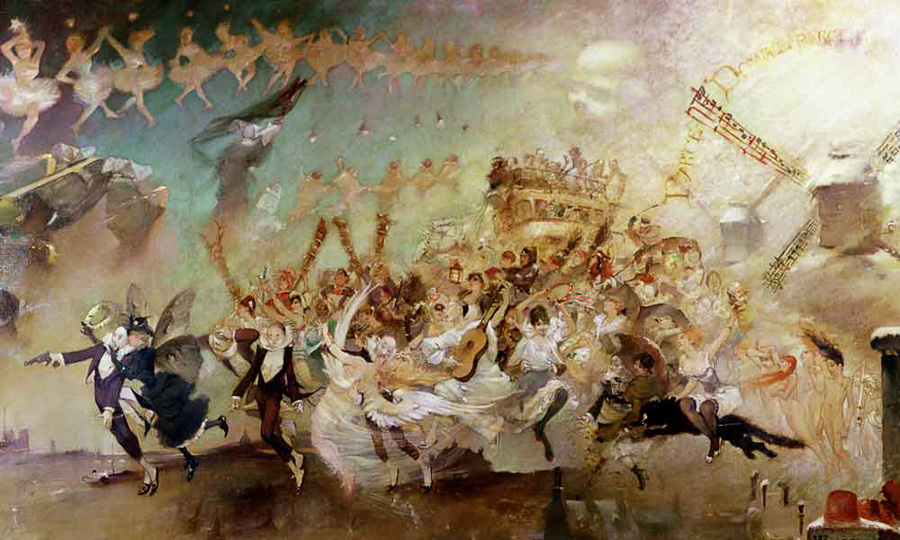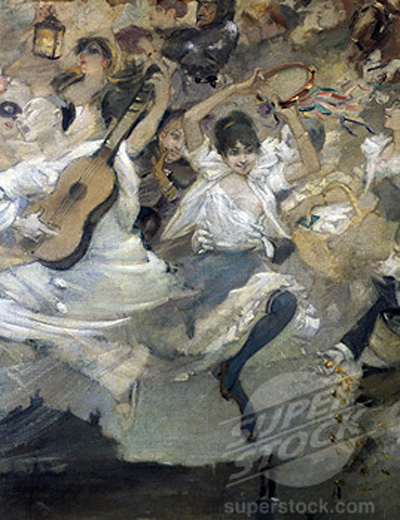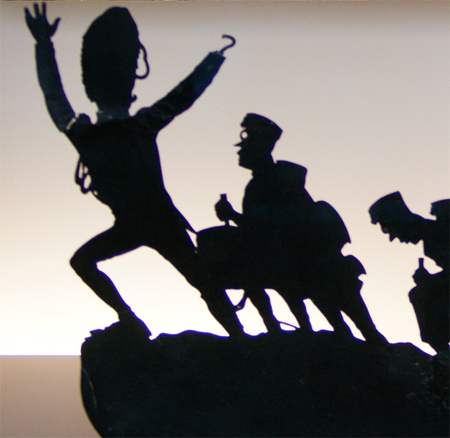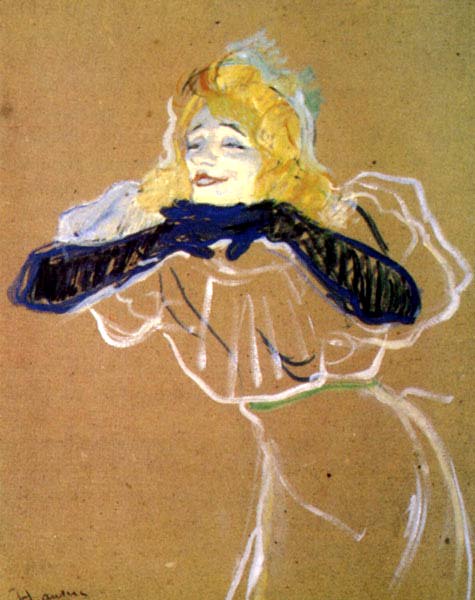Richard Thompson, Phillip Denis Kate, and Mary Weaver Chapin, Toulouse-Lautrec and Montmartre (2)
Visual Images from Montmartre

Adolphe Willette, Parce Domine* (c.1884) -- Decoration for the Chat Noir Cabaret
[* Parce Domine are the first two words at the beginning of a Gregorian chant. The line reads: "Spare, O Lord, spare Your people: lest You be angry with us forever."]
The cabaret culture . . . developed visual vocabularies strongly phrased in decadent terms. Adolphe Willette's decorations for the Char Noir cabaret are a case in point. Trained by the celebrated history painter Alexandre Cabanel, Willette adapted his academic training in Parce Domine [see above], a huge decorative canvas with a multitude of figures pitched in a vertiginous neobaroque torrent. This spate flows between Montmartre, identified by the windmills to the upper right, and downtown Paris, with the Opera and Notre Dame silhouetted on the horizon. It consists of Montmartrois types, headed by Willette's alter ego, Pierrot [the traditional clown-like figure in French culture] : cancan dancers. revelers from a masked ball, prostitutes, the inevitable black cat.. and men on the razzle [a British euphemism for a drunken celebrity]."8 The crowd is unruly, suffering from a "contagion" or "hysteria, "to use the terms borrowed from medicine and psychology. as the discourse of decadence was so wont to do in its analysis of the ailments of modern society. 9 The momentum of this surge of pleasure seekers is downward -- it is, literally, decadent -- and the moon in the nocturnal sky above takes the form of a skull, a salutary warning. Parce Domine was an ironic inversion of the patriotic and rhetorical imagery of the mural paintings commissioned by the Third Republic to decorate its town halls and other public buildings, an irony echoed when Victor Meusy's guide to Montmartre in 1900 suggested that the state itself purchase the subversive painting. 10
This visual vocabulary was soon raided by artists who worked outside the immediate circles of the cabarets. At the Salon des Indépendents in 1890 Georges Seurat exhibited his large canvas Chahut, complex casting of Montmartrois nightlife into the avant-garde neo-impressionist style, it suited Seurat (who had certainly visited the Chat Noir) to recycle the compositional idea from Villette 's stained-glass Le Veau d'or [Golden Calf] of the decadent spectacle being conducted. [Click here to see Chahut and Le Veau d'or.]

Adolphe Willette, Parce Domine [Detail](c.1884)

Shadow Puppets from the Chat Noir
Of even more vital pictorial importance was the Chat Noir's shadow plays, developed by Henri Riviere, Henry Somm. and others from Japanese prototypes. The subjects of these were various. While some took uplifting themes -- such as Riviere's Marche á l'etoile (Journey Following the Star) and Caran d 'Ache's L'Epopée (The Epic), about the Nativity and Napoleon's grande armée, respectively -- others favored decadent subjects, like Louis Morin's Pierrot pornographc (I893), set, of course, in Montmartre. 11 The black silhouette that derived from the experience of watching these shadow plays was not just a pictorial convenience. a simple, dramatic dark form. The silhouette was suggestive; it did not describe the whole figure but reduced it , even distorted it. With its lack of exact definition, it expected the viewer to make assumptions about what it defined, to bring into play their knowledge of the shadows.
Thus the silhouette was an ideal pictorial device for the decadent imagination. Anquetin, a close friend of Lautrec's, used it in a large pastel made in 1889. Although set in central Paris, on the
Champs-Elysees, the image is Montmartrois both in its use of the silhouette and in the allusions that it makes about single women with poodles in this particular part of the city: this was the clandestine identification and cruising ground for lesbians. 10 Not everyone looking at Anquetin's pastel-exhibited. it seems, as Soir (Evening) at the 1891 lndépendants - would know that, but to do so would require specific inside knowledge of "decadent" codes and behavior. When Lautrec himself came to design his first poster , Moulin Rouge: La Goulue, he also turned to the silhouette. The black forms create a dark backdrop to offset the dancer's blonde hair and dotted blouse. but they also characterize the typical spectators. Their smart bonnets and top hats reveal them as bourgeois; their fictive presence in a dance hall watching a working-class women dancing provocatively suggests the decadence that the Montmartre entertainment industry so assiduously marketed.
The decadent critique, taken from wider social debate and geared into commercial entertainment - first by the cabaret culture by the Chat Noir, then by professionally crafted leisure organizations such as the Moulin Rouge --- became what typified Montmartre in the eyes of Parisians, French, and foreigners. By the time Pablo Picasso arrived in Paris in 1900, the gambit was a stale one, but the young Spaniard eagerly adopted it. In a self-portrait from his second visit he took on the persona of a s1nart bourgeois, lining the background with brazenly bare-breasted tarts. It is an image that, with all the hollow confidence of youthful knowledge, proclaims the clichéd Montmartre nostrum that creativity has its roots in decadence.
_1891.jpg)
Toulouse- Lautrec, Moulin Rouge: La Goulue

Yvette Guilbert, Henri de Toulouse-Lautrec (1894)
How might we define Lautrec's relationship with and contributions to this Montmartre culture? First, it may be useful summarily to summarily to map the trajectories of the subculture and the artist. In simple terms the opening of the Chat Noir in 1882 in initiated the vogue for the "cabaret aristic.” It was followed by a burgeoning number, typically with their ow n individu l identity, such as Bruant 's Mirliton, opened in 1885, or Maxim Lisbonn e's Taverne du Bagne. By the later 1880s the dance halls of Montmartre were attracting more and more audience from outside the quartier, and in 1889 Oller and Zidler launched the Moulin Rouge to capitalize on this by presenting a wide range of attractions. Growing activity and increasing investment led to greater media coverage and to still greater momentum within what could now be defined s the Montmartrois entertainment industry.
That momentum is evinced by the rapidity with which the promotional machinery settled on
a new "star" and propelled him or her into instant celebrity. Take the case of Yvette Guilbert, a nobody performing in the provincial cafés-concerts of Lyon in the summer of 1889. Yet by December 1890 she was being lauded by the influential journalist Jean Lorrain as a deluxe product: " the article de Paris most in fashion."" Success ed to over-exploitation: a constant appetite for novel and not necessarily better acts, yet more shadow theaters, and cabarets with themes such as Heaven or Hell. But by the mid-1890s momentum and originality were waning. The Moulin Rouge was increasingly a tourist trap; the Chat Noir and the Mirliton both closed their doors in 1897. The lively posters made at the turn of the century by artists such as Jules Grum and Maxime Dethomas were advertising a faded "Montmartre. " in Grun 's case explicitly, for the foreigner'.